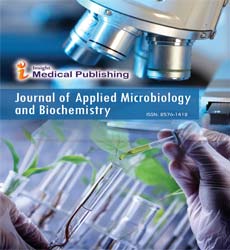ISSN : ISSN: 2576-1412
Journal of Applied Microbiology and Biochemistry
The Mycobacterial Menace Considerate Drug Resistance in Tuberculosis
Sung Xia*
Department of Integrative Biology, University of California, Los Angeles, USA
- *Corresponding Author:
- Sung Xia
Department of Integrative Biology, University of California, Los Angeles,
USA,
E-mail: sxia@hotmail.com
Received date: July 30, 2024, Manuscript No. IPJAMB-24-19681; Editor assigned date: August 02, 2024, PreQC No. IPJAMB-24-19681 (PQ); Reviewed date: August 16, 2024, QC No. IPJAMB-24-19681; Revised date: August 23, 2024, Manuscript No. IPJAMB-24-19681 (R); Published date: August 30, 2024, DOI: 10.36648/2576-1412.8.4.240
Citation: Xia S (2024) The Mycobacterial Menace Considerate Drug Resistance in Tuberculosis. J Appl Microbiol Biochem Vol.8 No.4: 240.
Description
Tuberculosis (TB), caused by Mycobacterium tuberculosis, remains one of the deadliest infectious diseases globally. Despite significant advances in treatment and prevention, the emergence of drug-resistant strains has turned TB into a formidable public health challenge. Drug resistance in tuberculosis is a multifaceted challenge that demands urgent attention. As we confront the mycobacterial menace, it is vital to adopt a comprehensive approach that include strengthening healthcare systems, improving treatment adherence, investing in research and addressing the social determinants of health. By prioritizing these strategies, we can combat drug-resistant TB and move closer to the goal of eliminating this ancient yet persistent disease. The battle against TB is far from over, but with coordinated efforts, we can reclaim ground against this public health threat.
Mechanisms of drug resistance
Drug resistance in M. tuberculosis primarily arises from genetic mutations. When disclose to anti-TB medications, bacteria may undergo mutations that enable them to survive despite treatment. For instance, mutations in the katG gene confer resistance to isoniazid, while changes in the rpoB gene lead to rifampicin resistance. Biofilm formation Biofilms, or bacterial colonies covered in a protective matrix, can develop from TB. This biofilm lifestyle allows bacteria to evade the immune system and resist antibiotic penetration, making treatment less effective. Latent infections a significant portion of the global population harbors latent TB infections, where the bacteria remain inactive. Later on, these people may have active Tuberculosis (TB), especially if their immune systems are weak. The prevention of medication resistance emerges from treating latent infections. Incomplete treatment regimens is one of the most significant contributors to drug resistance is incomplete or improper treatment. Patients often stop taking their medication once they feel better, allowing the bacteria to survive and adapt. Ensuring that patients complete their treatment is essential to preventing resistance. In many lowand middle-income countries, healthcare systems lack the resources for proper TB management. Insufficient access to medications, diagnostic tools and healthcare education can lead to misdiagnosis and inappropriate treatment, fostering the development of drug-resistant strains. Socioeconomic factors like poverty, malnutrition and crowded living conditions can increase the risk of TB transmission and complicate treatment. These factors are often interlinked with drug resistance, as individuals in disadvantaged situations may have limited access to quality healthcare.
Strategies to combat drug resistance
Strengthening healthcare systems in enhancing healthcare infrastructure is critical for effective TB management. This includes improving access to quality diagnostic tools, ensuring the availability of first-line and second-line anti-TB drugs and training healthcare providers on the importance of adherence to treatment regimens. Implementing Directly Observed Therapy (DOT), where healthcare workers observe patients taking their medication, can significantly improve adherence. DOT ensures that patients complete their treatment, reducing the risk of resistance. Investing in rapid diagnostic technologies can help identify drug-resistant strains quickly. Molecular techniques, such as GeneXpert, can detect resistance mutations in a matter of hours, enabling timely adjustments to treatment regimens. There is an urgent need for research into new antibiotics and treatment regimens effective against drug-resistant TB. Promoting public-private partnerships and financial incentives to pharmaceutical companies to participate in tuberculosis medication research is essential. Raising awareness about TB and the importance of adherence to treatment can help combat stigma and encourage patients to complete their regimens. Educational campaigns should target both healthcare providers and the general public. Tackling the socioeconomic factors that contribute to TB transmission and drug resistance is essential. Improving living conditions, access to healthcare and nutritional support can enhance overall community health and reduce TB incidence. These regimens can last up to two years and incorporate many drugs. This can lead to increased healthcare costs, higher rates of treatment failure and elevated mortality rates. The inability to control drug-resistant strains jeopardizes global TB elimination efforts and places additional strain on already overburdened healthcare systems.
Open Access Journals
- Aquaculture & Veterinary Science
- Chemistry & Chemical Sciences
- Clinical Sciences
- Engineering
- General Science
- Genetics & Molecular Biology
- Health Care & Nursing
- Immunology & Microbiology
- Materials Science
- Mathematics & Physics
- Medical Sciences
- Neurology & Psychiatry
- Oncology & Cancer Science
- Pharmaceutical Sciences
